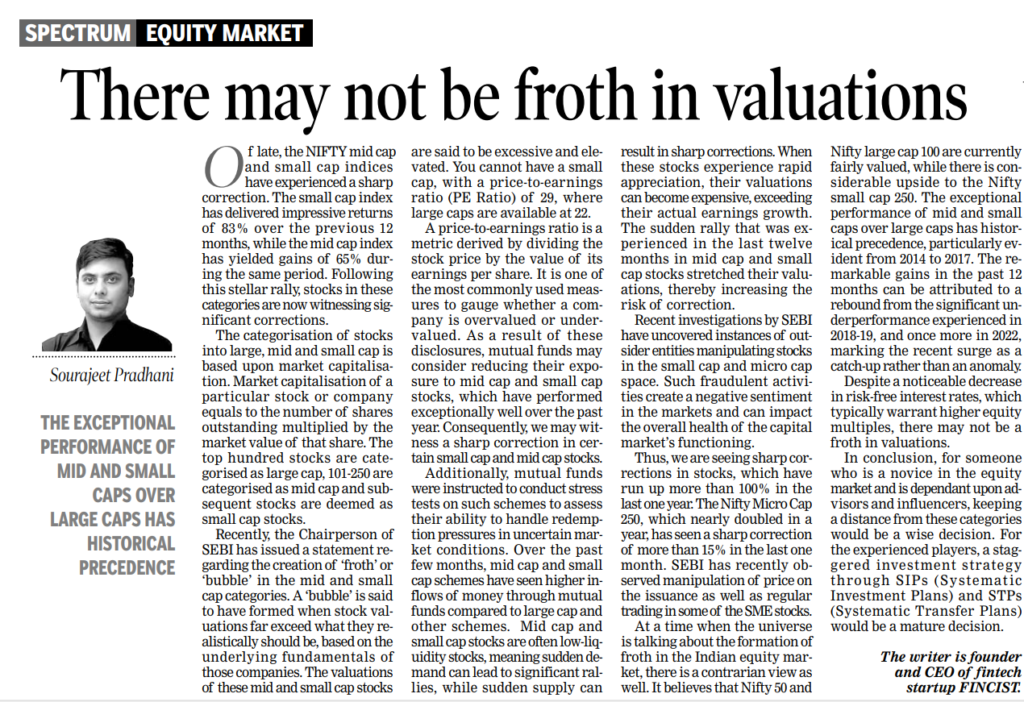Of late, the NIFTY Midcap and Smallcap Indices have experienced a sharp correction. The small-cap index has delivered impressive returns of 83% over the previous 12 months, while the mid-cap index has yielded gains of 65% during the same period. Following this stellar rally, stocks in these categories are now witnessing significant corrections.
The categorization of stocks into large, mid and small cap is based upon market capitalization. Market capitalization of a particular stock or company equals to number of shares outstanding multiplied by market value of that share. The top hundred stocks are categorised as large cap, 101-250 are categorised as mid cap and subsequent stocks are deemed as small cap stocks.
Recently, the Chairperson of SEBI has issued a statement regarding the creation of ‘froth’ or ‘bubble’ in the mid and small cap categories. A ‘bubble’ is said to have formed when stock valuations far exceed what they realistically should be, based on the underlying fundamentals of those companies.
The valuations of these mid and small cap stocks are said to be excessive and elevated. You cannot have a small cap, with a price-to-earnings ratio (PE Ratio) of 29, where large caps are available at 22.
A price-to-earnings ratio is a metric derived by dividing the stock price by the value of its earnings per share. It is one of the most commonly used measures to gauge whether a company is overvalued or undervalued.
As a result of these disclosures, mutual funds may consider reducing their exposure to midcap and small-cap stocks, which have performed exceptionally well over the past year. Consequently, we may witness a sharp correction in certain small-cap and midcap stocks.
Additionally, mutual funds were instructed to conduct stress tests on such schemes to assess their ability to handle redemption pressures in uncertain market conditions. Over the past few months, midcap and small-cap schemes have seen higher inflows of money through mutual funds compared to large-cap and other schemes.
Midcap and small-cap stocks are often low-liquidity stocks, meaning sudden demand can lead to significant rallies, while sudden supply can result in sharp corrections. When these stocks experience rapid appreciation, their valuations can become expensive, exceeding their actual earnings growth. The sudden rally that was experienced in the last twelve months in midcap and small-cap stocks, stretched their valuations, thereby increasing the risk of correction.
Recent investigations by SEBI have uncovered instances of outsider entities manipulating stocks in the small-cap and micro-cap space. Such fraudulent activities create a negative sentiment in the markets and can impact the overall health of the capital markets functioning.
Thus, we are seeing sharp corrections in stocks, which have run up more than 100% in the last one year. The NIFTY Microcap 250, which nearly doubled in a year, has seen a sharp correction of more than 15% in the last one month. SEBI has recently observed manipulation of price on the issuance as well as regular trading in some of SME stocks.
At a time when the universe is talking about the formation of froth in the Indian equity market, there is a contrarian view as well. It believes that Nifty 50 and Nifty Largecap 100 are currently fairly valued, while there is considerable upside to the Nifty Smallcap 250.
The exceptional performance of mid and small caps over large caps has historical precedence, particularly evident from 2014 to 2017.
The remarkable gains in the past 12 months can be attributed to a rebound from the significant underperformance experienced in 2018-19, and once more in 2022, marking the recent surge as a catch-up rather than an anomaly.
Despite a noticeable decrease in risk-free interest rates, which typically warrant higher equity multiples, there may not be a froth in valuations.
In conclusion, for someone who is a novice in the equity market and is dependent upon advisors and influencers, keeping a distance from these categories would be a wise decision. For the experienced players, a staggered investment strategy through SIPs (Systematic Investment Plans) and STPs (Systematic Transfer Plans) would be a mature decision.

